What is eSIM? eSIM has been around for many years now. The technology entered the consumer market in 2016. It allows service providers (SPs) to fully digitalise their customer journey and provide a new level of customer experience – something that will benefit both SPs and customers.
But although the technology has so much potential, it hasn’t encountered the uptake it deserves. So far, only around 18% of all operators have implemented eSIM for consumer use worldwide. And it only represents approximately 5% of global mobile service activations. This isn’t surprising. The number of eSIM-enabled smartphones and eSIM awareness rate in the consumer market is quite low. But it’s all about to change.
Apple is changing the consumer eSIM game with their eSIM-only iPhone. The move is considered bold and innovative. And problematic and inconsiderate towards end-users by others. But so was the case with removing the headphone jack (and introducing AirPods, the wireless earbuds), back in 2016. Fast forward to 2022 and most of the other brands ship their devices without a headphone jack and have wireless headphone options in their offering. We predict the same will happen with eSIM.
RECOMMENDED READING
Since eSIM is on the rise again, we thought it would be helpful to go through the basics of the technology and answer the most searched questions about it. Let’s dive in.
1. What is eSIM?
In layman’s terms, eSIM is a digital SIM. It has the same function as the plastic SIM card, but it is physically integrated into the device — i.e., it cannot be removed from the device and replaced with another SIM. It’s activated remotely which allows operators to move their entire customer journey online.
Watch the full discussion about eSIM and its evolution in the consumer market.
2. eSIM vs physical SIM – what’s the difference?
Contrary to a plastic SIM card, eSIM does not come with operator profile data pre-installed in the device. In order to connect to the operator’s network, a customer must be provisioned their SIM remotely. They need to download a SIM profile from their operator of choice and activate it on their device. The process can take as little as one tap and less than 60 seconds for the profile to activate.
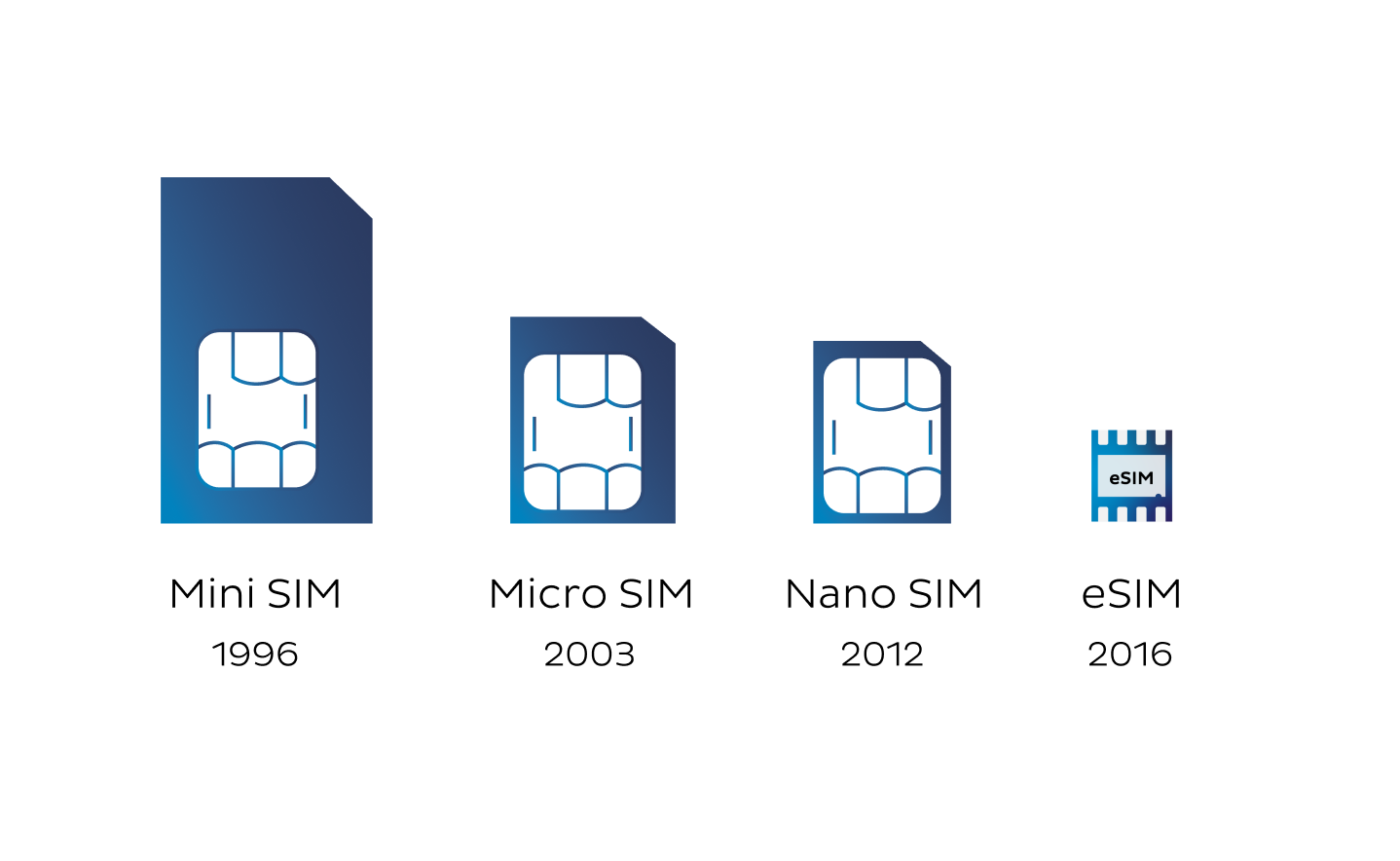
3. What is an eSIM profile?
An eSIM profile is the information about the operator that is required for the identification and authentication of the SIM card with a mobile network. The operator profile is pre-programmed directly onto a physical SIM and cannot be removed. In the case of eSIMs, it comes in a digital version and must be downloaded by the user onto their device. iPhones can hold multiple profiles at the same time and the user can use them interchangeably.
4. What is eUICC?
Traditional SIM is built on Universal Integrated Circuit Card (UICC) technology, just like bank cards. The UICC is a physically secure computing chip that can be used across multiple vertical sectors including mobile telecommunications. However, most devices can only host one UICC card (some devices can hold two).
eUICC, or embedded UICC, is a hardware component that allows users to provision operator profiles remotely. And it can hold multiple operator profiles simultaneously.
eUICC is significantly smaller than the smallest SIM card – the nano-SIM. It does not need the space required for the SIM tray mechanics. Both features combined save significant and very valuable space for devices OEMs (original equipment manufacturers).
5. eSIM vs eUICC – what’s the difference?
eSIM and eUICC are usually used interchangeably. But there is a difference between the two. Confusion arises when people assume it is the eSIM that has remote provisioning capabilities. That’s however not the case. eUICC is the chip that hosts the profile that can be provisioned remotely by the operator.
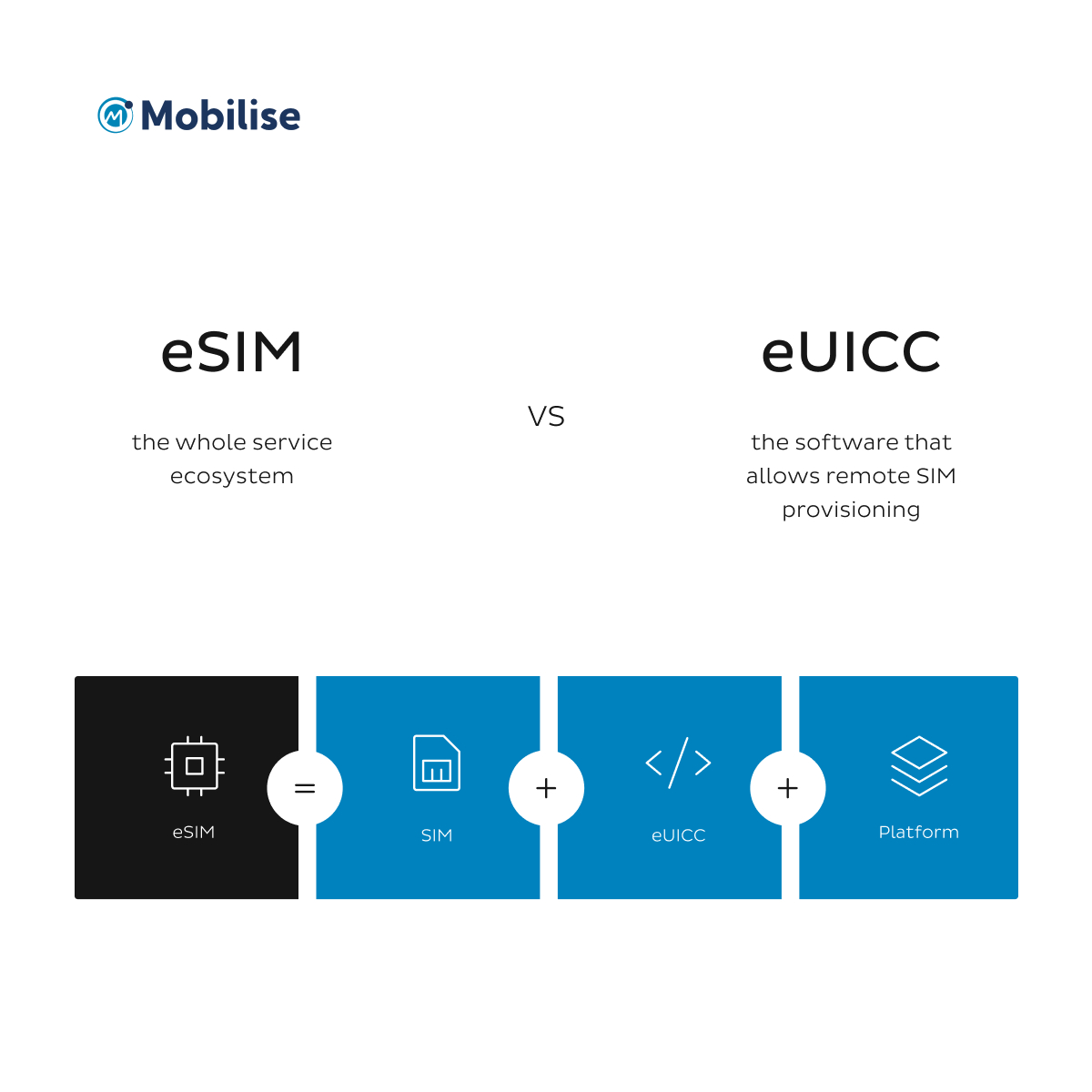
6. What is remote SIM provisioning?
Remote SIM provisioning (RSP) allows for secure operator profile management. This includes the authentication and activation of embedded SIMs and their enabling, disabling and deleting. It completely removes the need of swapping single-profile physical SIM cards.
7. What are the main types of eSIM activation?
QR code-based activation
After purchasing a mobile subscription from an operator of choice, the customer is provided with a QR code (usually via email). This method, however, requires 2 screens to complete the activation. One screen to open the QR code and one to scan it and download and activate the profile.
In-app eSIM activation
In this case, the eSIM activation takes place in the operator’s self-care mobile app. Activation can be adopted as part of the overall digital customer onboarding journey. It only takes a tap of one button.
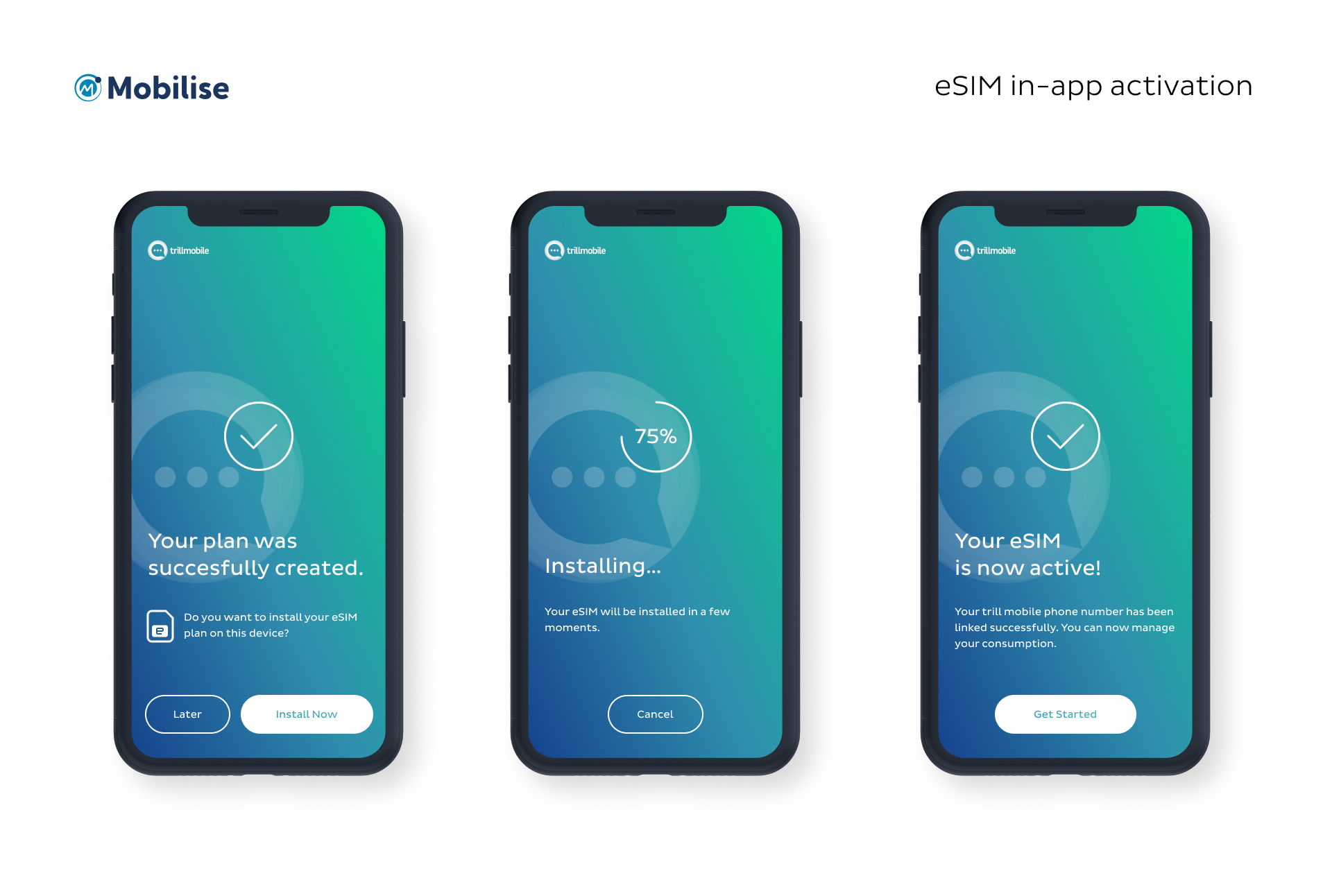
8. eSIM subscription management – what do SPs need to offer eSIM to their consumers?
As per the GSMA standards, an SP needs to acquire a remote SIM provisioning system (SM-DP+) to manage and activate eSIM profiles to the user device over the air. SM-DP+ is essentially a platform on which the SP stores its profiles. The platform is also responsible for enabling, disabling, updating, protecting, and deleting eSIM profiles.
9. What are the benefits of eSIM?
For service providers
Cost savings
eSIM technology eliminates manufacturing and logistics costs by relying on digital and, in turn, less expensive distribution channels. As folks in the telecom world will know all too well, physical distribution is a costly component of profit & loss (P&L). Physical SIM cards and their packaging represent a significant fixed cost for service providers. On average, it costs 1-2.5 USD to produce, package and deliver one SIM card.
eSIM’s cost in comparison is up to 80% lower. The cost only includes the eSIM activation fee on the consumer device by the SM-DP+ vendor. No packaging or delivery costs are involved.
To put this into perspective, an SP with a 1 million customer base and approximately 50% gross additions per annum could save 1 million US dollars of cost per annum if they switched to 100% eSIM provisioning.
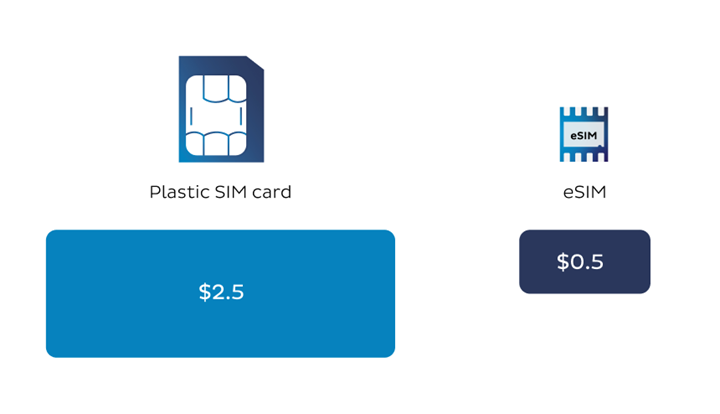
Revenue enhancement
There are several opportunities for SPs to capitalise on eSIM. Firstly, it allows SPs to offer enhanced, multi-device and multi-user subscriptions which drive higher ARPU and attract high-spending customers.
Secondly, it provides an opportunity for international roaming and travel product use cases. These increase the inbound roaming revenue by unlocking the silent roamers’ segment.
Lastly, eSIM enables horizontal market opportunities through embedded connectivity products.
Improved NPS
eSIM allows to digitalise customer onboarding fully and, in turn, the entire customer journey. In a world driven by digital experiences, digitalisation is what customers expect from their service providers. And seamless customer experience is widely linked with improved loyalty and satisfaction.
RECOMMENDED READING
For Customers
Convenience
As mentioned earlier, eSIM allows operators to move their entire customer journey online. This makes it more convenient for end-users too! They can purchase, download, and activate their eSIMs in one place (telco self-care app). And after the profile is activated, customers can manage their bundles and contact customer service through that same app.
Flexibility
It enables customers to switch providers more easily, as it doesn’t require swapping plastic SIM cards. This isn’t necessarily a bad thing. The feature comes in handy while travelling or when having separate phones for work and personal life.
Choice
Customers can store up to 8 operator eSIM profiles at the same time (varies depending on OEM).
Security
It is more secure than traditional SIM cards. It removes the threat related to device theft or loss. In contrast to an embedded SIM, a physical SIM card can be easily discarded after the device has been stolen. This will make the stolen device easier to find and more difficult to resell.
Timesaving
Not only is digital onboarding more convenient, but it’s also much faster. It can take as short as a few minutes to complete. And activation itself takes one tap and less than 60 seconds which saves the waiting time for the physical SIM to be shipped or collected from a point of sale (POS).
10. Are eSIMs more sustainable?
Yes! They are more sustainable than plastic SIM cards. In 2012, ICMA estimated that 2 billion SIM cards are shipped globally per annum. This meant the SIM card industry contributed to about 2,000,000,000*35g CO2e or a total of 70,000 tons. Since then, the number of Mobile subscribers increased by approximately 50%, which makes us assume that the current SIM card footprint is about 100,000 tones.
RECOMMENDED READING
There are no official insights into the carbon footprint of producing eSIMs, but it is safe to assume it is significantly lower. Why?
- eSIMs are an integral part of consumer devices which means they do not require separate transport.
- The chip is smaller than a physical SIM card.
- It does not require the use of plastic. Even nano-SIM, the smallest version of the SIM card, has some plastic around it. Not to mention that SIMs come enclosed in a larger plastic holder, often up to 8 times bigger than the SIM card itself.
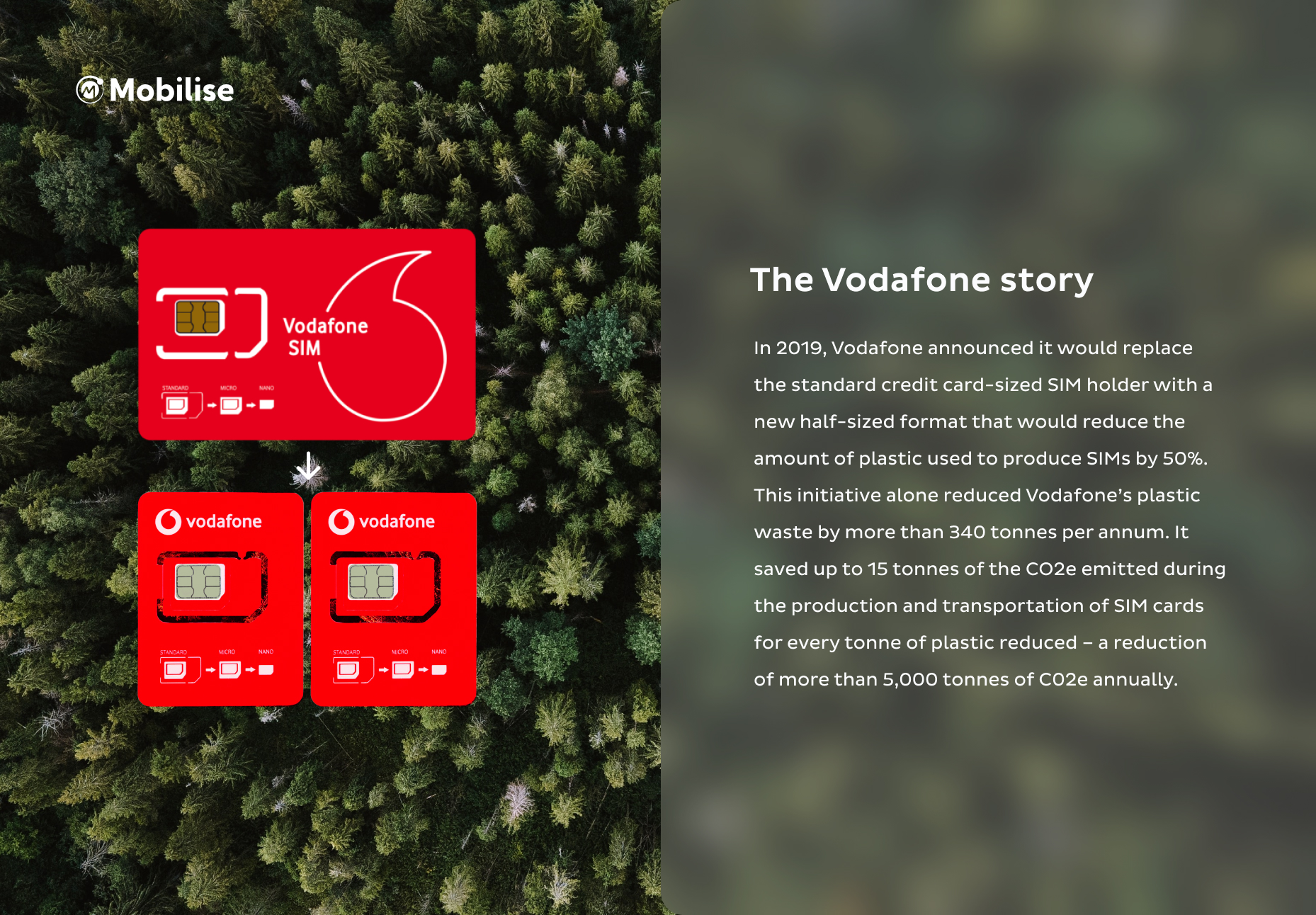
11. How many eSIM-enabled smartphones are out there now?
According to our latest analysis, as of September 2022, there are currently 72 eSIM-capable smartphone models available on the market, most of which are offered by Apple.

12. How many operators support eSIM worldwide?
There were 232 operators which makes up around 18.5% of all operators offering commercial eSIM services for smartphones across at least 82 countries at the end of 2021. This has more than doubled since 2019 (number of all operators: 1250, source: GSMA).
GSMA Intelligence reports that the US and Canada were among the top markets for eSIM services, whereas in Europe it’s now accessible in almost all nations.
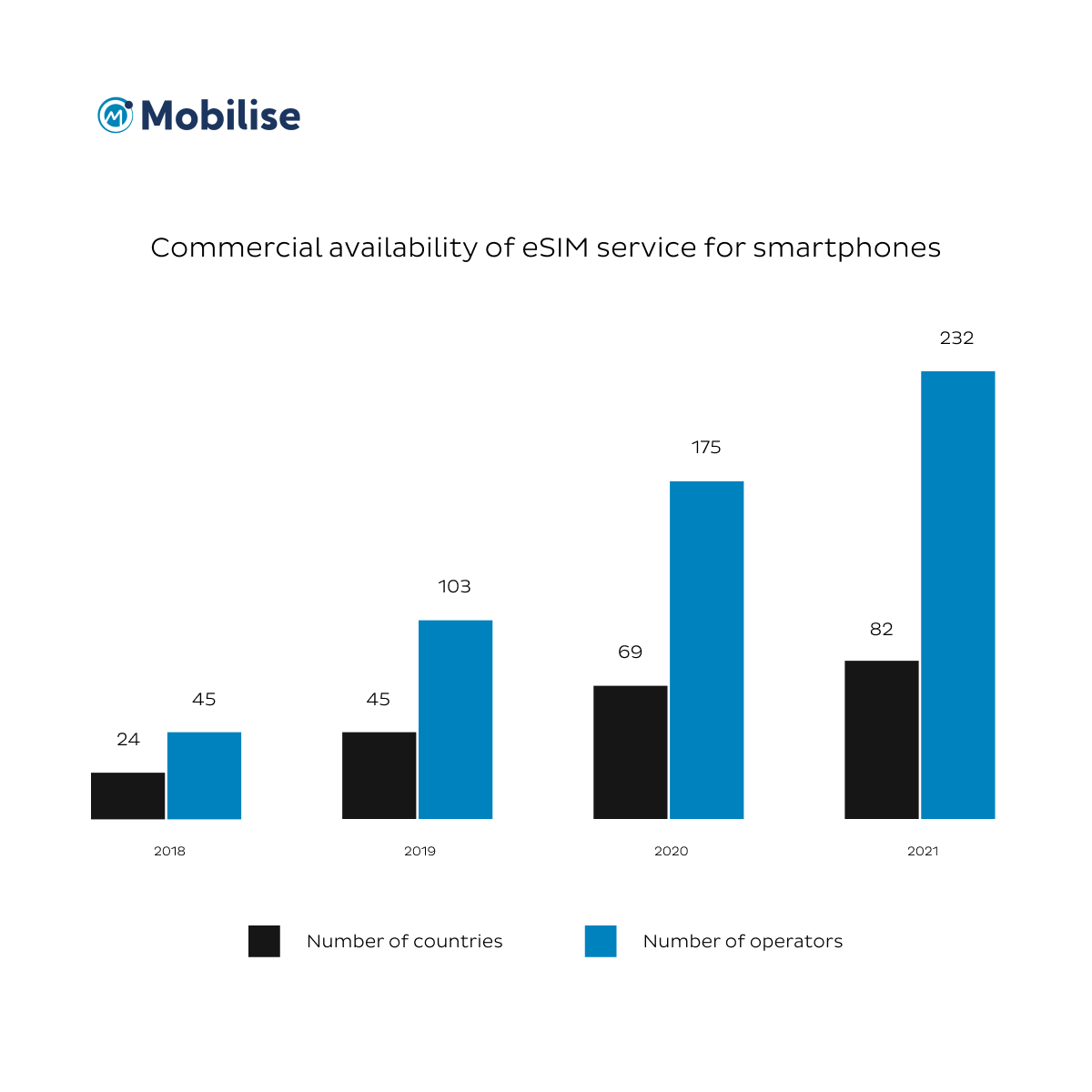
13. What are the predictions for the future of eSIM in the consumer market?
It’s clear that the release of Apple’s eSIM-only phone in the US will have a massive impact on the telecoms industry. And the industry overall will need to ensure that they are prepared to implement a service that satisfies customers’ needs. All while remaining competitive.
Service Providers
SPs will be forced to implement eSIM offerings and products to capitalise on the technology. There’s a lack of consumer awareness and understanding of the technology that needs to be addressed. SPs will need to produce and promote educational content on how the technology works and the benefits for customers to boost awareness. And therefore, it will boost adoption.
OEMs
As one of the most popular handset manufacturers, Apple’s decision to go eSIM-only will initiate a ripple effect among other OEMs. At this time, the number of eSIM-supporting smartphones is limited to flagship devices at a higher price point. In the next few years, OEMs will widen price ranges and drive customer reach, especially in developing markets.
14. What are the main mistakes made by SPs when it comes to implementing eSIM?
Some operators who have implemented offerings have done so poorly. We have analysed one such operator during our Telco’s Digital Transformation with eSIM webinar. Our conclusion was that SPs tend to make at least one of the below mistakes:
No self-care mobile app integration
Even the best onboarding journey on a website will eventually lead to some friction. Especially around downloading and activation. A self-care mobile app is a better solution. It creates a one-stop-shop for the customer where they can not only onboard but also manage their subscription on their own.
No eKYC
Since most of the spotlight is taken by eSIM, SPs tend to forget about digitalising and optimising their Know Your Customer (KYC) process. We’ve seen cases where identity verification takes from a few hours to up to a couple of days or requires an in-person courier visit! Instead, SPs should opt for the instantaneous and seamless in-app eKYC (electronic KYC) method as friction in the onboarding journey reflects negatively on customer satisfaction.
QR code activation
Once the customer’s profile is set up, it’s time to download and activate the profile. Many SPs go for QR code activation as it’s it requires less overhead for the SPs to offer – compared to in-app activation. However, there are faster and smoother ways to activate the profile. Our choice is in-app eSIM activation. It is very easy and intuitive for the user, as it’s a part of the in-app onboarding journey and only takes one tap of a button to complete.
RECOMMENDED READING
Watch our eSIM webinar to find out more about eSIM mistakes made by SPs
15. How can Mobilise help service providers offer eSIM for consumers?
At Mobilise we created our own eSIM as a Service platform. It’s a turnkey solution that enables SPs to offer consumer eSIM capabilities to their customers quickly and efficiently. Offering one-tap installation, eSIM as a Service eliminates the need for QR codes, enabling a truly transformative user experience.
eSIM as a Service comes as a white-labelled eSIM app. Thanks to our strategic partnerships, the platform offers eSIM DP+ infrastructure that is compliant with SAS-SM certification by the GSMA.
With these functions, mobile network operators (MNOs) and mobile virtual network operators (MVNOs) of all sizes can embrace the opportunities created by eSIM technology and form entirely digital journeys for their subscribers.



